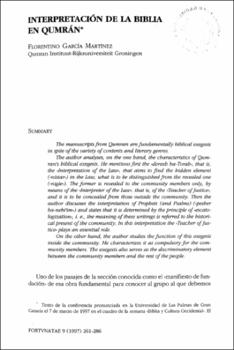Interpretación de la Biblia en Qumrán
Fecha
1997Resumen
The manuscriptsfrom Qumran are fundamentally biblical exegesis
in spite of the variety of contents and literary genres.
The author analyses, on the one hand, the characteristics of Qumran's
biblical exegesis. He mentions first the «derash ha-Torah», that is,
the «Interpretation of the Law», that aims to find the hidden element
(«nistar») in the Law, what is to be distinguished from the revealed one
(«nigle»). The former is revealed to the community members only, by
means of the «Interpreter of the Law», that is, of the «Teacher ofJustice»,
and it is to be concealed from those outside the community. Then the
author discusses the interpretation of Prophets (and Psalms) («pesher
ha-nebi'im») and states that it is determined by the principle of «escatologization
», i. e., the meaning of these writings is referred to the historical present of the community. In this interpretation the «Teacher of Justice» plays an essential role.
On the other hand, the author studies the function of this exegesis
inside the community. He characterizes it as compulsory for the community members. The exegesis also serves as the discriminatory element
between the community members and the rest of the people.





